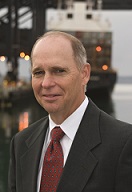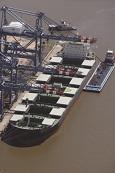
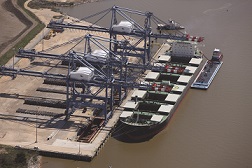
There are several other factors propelling this huge investment of private-sector capital into America’s ports. The biggest driver may be the rapidly growing middle class throughout parts of Southeast Asia, Africa, Latin America and the Middle East, among others. According to a 2013 Ernst & Young report, the middle class in these “rapidly growing markets,” or RGMs, is expected to create a burgeoning demand in the coming years as they rise out of poverty, with their spending increasing from today’s $21 trillion to $56 trillion in 2030. The expectation is that an increasingly interconnected world will benefit from the trading opportunities of this anticipated growth and the phenomenal new demand for goods and services.
Another, still emerging, consideration for America’s port expansion is that manufacturing operations are incrementally transitioning or relocating to North America, a development known as “near-sourcing.” With rising labor costs overseas, a narrowing labor differential at home and long transit times to market, a 2012 Michigan-based AlixPartners survey found that nine percent of manufacturing executives in the U.S. have already taken steps to near-source their operations, and 33 percent plan to do so within the next three years.
Niche Markets May Generate Most Exports
Some of the biggest gains in U.S. exports may be seen in chemicals, machinery and transportation equipment, petroleum and coal products, computer and electronic components, electrical equipment and appliances, and primary metals, according to a new report by The Boston Consulting Group. The report, “Behind the American Export Surge: The U.S. as One of the Developed World’s Lowest Cost Manufacturers,” updates and elaborates on research released last fall which predicted that higher exports and near-shoring from China and elsewhere could add two and a half million to five million domestic manufacturing and related service jobs by 2020. In turn, that could reduce the unemployment rate by up to three percentage points.
These seven categories account for about three-quarters of total global exports, with job gains derived directly through added factory work and indirectly through supporting services such as construction, transportation and retail.
Seaports are Crucial Near-Sourcing Determinants
John LaRue, CEO for Port Corpus Christi, provides convincing arguments that have attracted several major plants recently to utilize this southwestern Texas port. One of those is China-based Tianjin Pipe Company, the world’s fifth-largest manufacturer of pipe. It will build a $1.3 billion, 600,000-ton-per-year seamless oil and gas pipe plant alongside Port Corpus Christi that will begin operating in 2015. Importing iron ore, pig iron and other raw materials through the port, it will then sell the finished product in the U.S. and Canada, with about 20 percent going further afield.
Also for the Corpus Christi port, Austrian specialty steelmaker voestalpine Group announced in March 2013 it plans to build a $700 million plant that will annually make two million tons of hot briquetted and direct-reduced iron for the company’s Austrian steel production sites. A third firm, the privately held Italian conglomerate M&G Group, plans to build a $900 million PET resin and purified terephthalic acid plant in Corpus Christi that is described as the world’s largest.
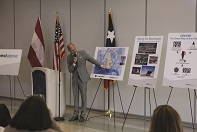
Alabama and its port received a big boost last year when Airbus, a European airplane manufacturer, said it would open a new factory in the state. Fabrice Brégier, the firm’s chief executive, said that for skilled workers, “China is no longer a low-cost country.” This announcement followed the July 2010 opening of Germany’s ThyssenKrupp AG carbon steel processing facility in Calvert, Alabama, and the opening of the Alabama State Port Authority’s new $115 million marine terminal to serve the ThyssenKrupp operation.
Jim MacLellan, the Port of Los Angeles’ director of trade development, said his port has noticed an increase in near-shoring in the past year or so, specifically in the former Maquiladora area in North Baja, adjacent to the California border. “Tijuana already relies upon the U.S. for $11 billion in supplies for this [manufacturing] sector, including $6.5 billion in electronics, $1.5 billion in medical devices and $1.2 billion in aerospace parts,” he said. “The Port of Los Angeles benefits from handling the imports to supply these growing plants.”
However, MacLellan said his port is also prepared for the export side of near-shoring. “Companies such as American Apparel, for example, have expressed the advantages of manufacturing in the U.S. and the growing demand for their products abroad. This trend could lead to more exports from the U.S. through the Port of Los Angeles.”
The Infrastructure Factor
Earlier this year, the Aspen Institute and the Manufacturers Alliance for Productivity and Innovation released an econometric forecast model showing potential for a U.S. manufacturing resurgence that by 2025 would help create the first trade surplus since 1975. The study found that, with adjustment of some key drivers, such as regulatory and tax policy, U.S. manufacturing could grow dramatically. These are the key drivers currently holding back infrastructure development and restraining manufacturing growth.
Many seaport-related infrastructure projects that could help jump-start near-shoring business opportunities are snarled by lengthy and inefficient study requirements and the low priority at the federal level to fund transportation projects that move cargo instead of people.
For the U.S. to remain a significant competitor for international trade, more of its commercial ports need to be able to accommodate larger ships, while improving existing and building new land-side connecting infrastructure is imperative to accommodate more loaded trucks and trains heading to or from these facilities. This was borne out in ASCE’s “2013 Report Card for America’s Infrastructure,” where the nation’s roads received a “D” grade, its bridges a “C+” and its ports a “C.”
While adequate port-connecting infrastructure funding remains elusive, reducing regulatory policy red tape is making progress. Provisions included in the 2012 Moving Ahead for Progress in the 21st Century Act (MAP-21) federal transportation bill would streamline land-side projects. To help move projects more quickly and reduce the infrastructure project backlog, the bill provides penalties to federal agencies if certain deadlines aren’t met. Under MAP-21, the U.S. DOT (Department of Transportation) also established a National Freight Advisory Council and an Advisory Committee on Supply Chain Competitiveness, both of which will seek input from shippers and transportation advisers to reshape America’s transportation priorities and tax policies.
Another regulatory side “bright spot” is the progress being made in Congress on passing a new water resources bill that would help streamline water-side projects and address other issues related to America’s navigation channels.
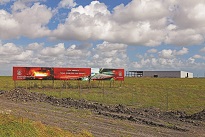
As near-shoring builds momentum, America’s seaports will be vying to attract new manufacturing operations to port regions that will increase cargo volumes of inbound raw materials and outbound finished products. They will also look to grow trade from new production near-shored to the Americas and to garner a larger share of the U.S. export pie.
Global supply chains are shifting, but the impacts will take time to be felt. The multitude of variables that affect trade flows will make it challenging to predict which commodities, industries, trade routes and countries will be most affected; but therein lies the opportunity for ports.

